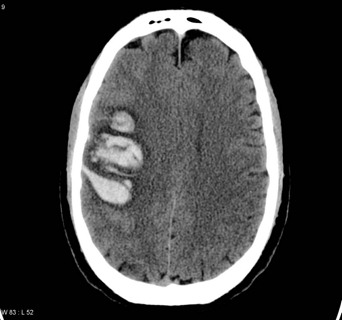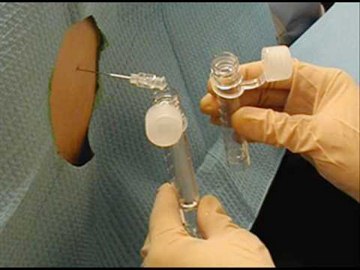Venous Sinus Thrombosis (Cerebral, Dural) – Symptoms, Treatment
What is Venous Sinus Thrombosis?
Venous Sinus Thrombosis is rare form of stroke. Typical cerebrovascular accidents occur in the arteries, so any thrombosis in the veins is rare. Venous sinus thrombosis is a serious reason of headache.
The venous sinuses are the end channels for the drainage of venous blood from the brain. Capillaries in the brain merge and form the cortical vein. The cortical veins also merge and drain venous blood in the venous channels in the dura mater.
The venous channels are different with the main channel running along the entire brain known as the superior saggital sinus. Inferior saggital sinus also runs along the inferior aspect of the brain. The transverse or lateral sinus also drains venous blood from the brain. These venous sinuses can be the location for the thrombosis or blood clots.

Venous Sinus Thrombosis Image
Image source: radiopaedia.org
The presence of blood clot in the venous sinuses prevents venous blood from draining from the brain. These may lead to congestion in the veins and may lead to rupture once the pressure in very high. Rupture leads to hemorrhage and subsequently, stroke. Stroke causes severe hypoxia of the brain cells leading to permanent damage. This condition is usually life-threatening.
Venous sinus thrombosis can occur at any age and even among newborns. Its occurrence in newborns is usually apparent during the first two months of life.
Types of Venous Sinus Thrombosis
Cerebral venous sinus thrombosis
This involves the presence of thrombosis in the deep cerebral veins. It is a rare occurrence, which constitutes 30% of all cases of venous sinus thrombosis.
- Dural Venous Sinus Thrombosis – This involves the formation of clot on the superficial veins in the dura mater. It is also a rare occurrence along with the cerebral veins.
- Cortical Venous Sinus Thrombosis – The thrombosis is located on the cortical veins, where capillaries in the brain merge.
- Saggital Venous Sinus Thrombosis – The saggital venous sinuses are a common site for venous sinus thrombosis. Superior saggital sinus thrombosis is most likely associated with Cerebrovascular Accidents or Stroke.
- Transverse Venous sinus thrombosis – Transverse venous sinus thrombosis is more uncommon than saggital thrombosis, however, the occurrence of which most likely cause increase in the intracranial pressure.
Venous Sinus Thrombosis Symptoms
Symptoms of venous sinus thrombosis are usually a sign of increased intracranial pressure. These include:
- Headache -Headache is present in up to 90% of cases. It can be in the form of thunderclap headache or the presence of a sudden headache in just a period of minutes. It is also characterized as new onset headache that is persistent. Headaches may also in the form of cluster headache, which involves pain in more than one area of the head. The headache is usually worsened during coughing, lying, or straining. There may also be presence of severe headache in the morning.
- Vomiting – The increased intracranial pressure also causes projectile vomiting because of the increased pressure that compresses the vomiting center, which is the medulla oblongata.
- Pulsatile tinnitus – Pulsatile tinnitus is present because of the pressure in the otic nerve.

Pulsatile tinnitus as a symptom of Venous Sinus Thrombosis
- Neck stiffness – Neck stiffness may also be present because of too much pressure in the venous channels in the brain, which radiates to the neck area.
- Papilledema – Papilledema is the swelling of the optic disc as a result of increased intracranial pressure. It causes visual obscurations or blind spots.
The symptoms of venous sinus thrombosis do not appear in some patients. The most apparent symptom is new onset headache.
Causes and Mechanism
The causes for children and infants are usually different from the risk factors of adults. These include:
Causes in Infants and Children:
- Sickle cell anemia – The presence of this condition causes early hemolysis of red blood cells. When these are hemolyzed in the venous sinuses, it can cause blood clotting in the area.
- Problems with blood clotting – Newborns may have congenital defects of the blood clotting mechanism causing severe blood clotting that can obstruct the venous sinuses.
- Dehydration – The presence of dehydration causes the blood to become more viscous, thereby increasing risk for clotting.
- Head Injury – Head injury during childhood may cause bleeding on the venous sinuses and lead to blood clots in the area.
- Infections in mothers during pregnancy – Mothers may experience certain infections during pregnancy and may lead to spread to the developing fetus. The infection may travel to the brain of the fetus causing blood vessel injury and subsequently blood clots.
Causes in Adults
- Pregnancy and puerperium – Pregnancy has been one of the most common causes of VST in adults. Pregnancy related conditions include increase maternal age, cesarean delivery, hyperemesis and maternal infections
- Use of oral contraceptive pills – Contraceptive pills increases the risk for abnormal blood clotting that may happen on the venous sinuses.
- Cancer – Malignancies in the brain or metastatic conditions can also cause blood clots in the venous sinuses as a result of damage to the intima of the blood vessels caused by tumors.
- Collagen vascular diseases – Diseases such as systemic lupus erythematosus may also lead to VST because of risk of blood clots in the brain.
- Inflammatory bowel disease – Chronic inflammatory conditions such as Crohn’s disease increase the C-reactive protein in the blood, which stimulates blood clotting because of trauma.
- Obesity – Obesity may also cause VST because of elevated cholesterol levels in the body.
- Intracranial hypotension – The presence of hypotension in the area leads to decreased venous blood flow. A sluggish blood flow can result in clot formation.
Diagnosis
The diagnosis of Venous Sinus Thrombosis uses the following tests:
Venography
Venography is done by injecting a contrast medium in the veins in the cranium with series of imaging tests to determine any obstruction of blood flow. Venography is usually assisted by the use of CT scan (CT venography) or MRI (MR venography). This test is usually done when absence of arterial obstruction is seen.
Lumbar puncture
Lumbar puncture is made to assess the opening pressure in the CSF that is increased when venous sinus thrombosis is present.
Treatment
Treatments of Venous Sinus Thrombosis include:
Anticoagulation
Anticoagulation therapy with the use of heparin and warfarin is given to prevent the formation of additional clots. These medications are not given to infants and children because of risk of severe hemorrhage.
Thrombolytic therapy
Thrombolytic drugs are those that directly dissolve a blood clot. This is usually given to eradicate the thrombus, which causes ICP elevation. Example of this drug is streptokinase.
Lumbar Puncture
Lumbar puncture is also employed to reduce the intracranial pressure. This can be done along with the diagnostic lumbar puncture by aspirating the CSF.

Lumbar Puncture Image
Anticonvulsants
Anticonvulsants are given to prevent seizures as a complication of VST.
Diuretics
Just like in any other increased ICP conditions, diuretics are given to reduce the CSF in the CNS.